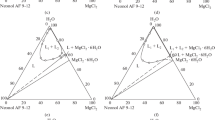Abstract
The partitioning regularity of nonionic organic mixtures in organic phase/water system is revealed. The equation for calculating the partition coefficients of mixtures (KMD), together with the determination model, is derived from the equilibrium partitioning models (EPMs). Based on these derived equations, the KMD values of 20 mixtures containing halogenated benzenes are obtained. The results show that stronger hydrophobicity of an individual chemical in the mixture results in the stronger hydrophobicity of the mixture and the greater the proportion of this chemical, the stronger the hydrophobicity of the mixture will be. This partitioning regularity is helpful to the study of the toxicity for mixtures and the environmental behavior, such as transfer or accumulation, for mixed organic pollutants.
Similar content being viewed by others
References
Hong, H., Han, S. K., Wang, X. R. et al., Predication of partition coefficient and toxicity for phenylthio, phenylsulfinyl and phenylsulfonyl acetates, Environ. Sci. Technol., 1995, 29: 3044.
Verhaar, H. J. M., Busser, F. J. M., Hermens, J. L. M., A surrogate parameter for the baseline toxicity content of contaminated water, Environ. Sci. Technol., 1995, 29: 726.
val Loon, W. M. G. M., Wijnker, E. G., Verwoerd, M. E., et al., Quantitative determination of total molar concentrations of bioaccumulatable organic micropollutants in water using C18 Empore disk and molar detection techniques, Anal. Chem., 1996, 68: 2916.
Lin, Z., Yu, H., Kong, D. et al., A new method for determination of C18 Empore™ disks/water partition coefficients of organic pollutants, Environmental Chemistry (in Chinese), 2001, 20(2): 139.
van Leeuwen, C. J., van der Zandt, T. J. P., Application of QSARs, extrapolation and equilibrium partitioning in aquatic effects assessment I)—Narcotic industrial pollutants, Environ. Toxicol. Chem., 1992, 11: 267.
Chiou, C. T., Peters, L. J., Freed, V. H., A physical concept of soil-water equilibria for nonionic organic compounds, Science, 1979, 206: 831.
Chiou, C. T., Porter, P. E., Shoup, T. D., Comment on “Partition equilibria of nonionic organic compounds between soil organic matter and water”, Environ. Sci. Technol., 1984, 18: 295.
Broderius, S. J., Modeling the joint toxicity of xenobiotics to aquatic organisms: Basic concepts and approaches, in: Aquatic Toxicology and Risk Assessment (eds. Mayes, M. A., Barrons, M. G.), Fourteenth Volume, STP 1124, Philadelphia: American Society for Testing and Materials, 1992, 107–127.
Thomulka, K. W., Lange, J. H., Combined toxicity of ethylamine and methylamine in an aquatic bioassay system using the marine bacteriumVibrio harveyi, Chem. Ecol., 1995, 11: 183.
Author information
Authors and Affiliations
Corresponding author
About this article
Cite this article
Lin, Z., Yu, H., Huang, L. et al. Partitioning regularity of nonionic organic mixtures in organic phase/water system. Chin.Sci.Bull. 46, 1422–1425 (2001). https://doi.org/10.1007/BF03187021
Received:
Revised:
Issue Date:
DOI: https://doi.org/10.1007/BF03187021




